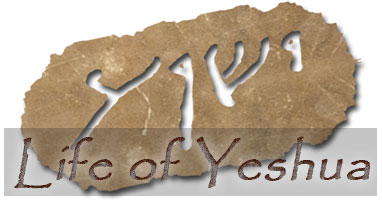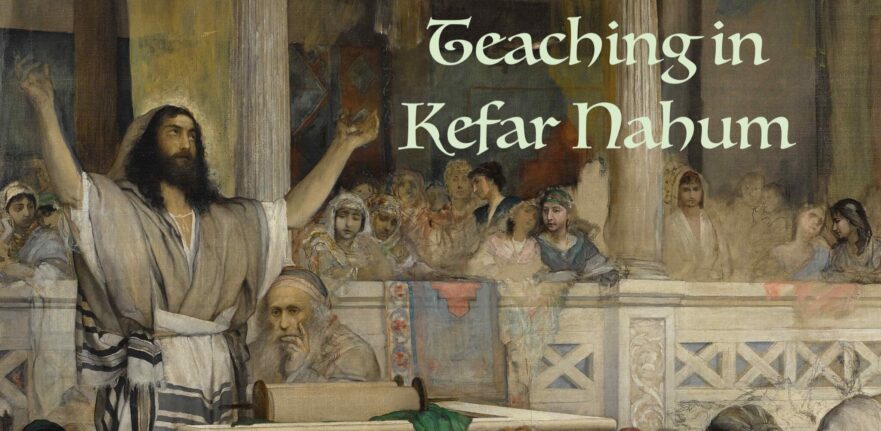How to cite this article:
Joshua N. Tilton and David N. Bivin, “Teaching in Kefar Nahum,” The Life of Yeshua: A Suggested Reconstruction (Jerusalem Perspective, 2023) [https://www.jerusalemperspective.com/27447/].
Matt. 4:13-16; 7:28-29; Mark 1:21-28; Luke 4:31-37
(Huck 9, 12, 44; Aland 32, 35-36, 76;
Crook 25-26, 59-60)[1]
וַיֵּלֶךְ אֶל כְּפַר נַחוּם עִיר הַגָּלִיל וְהָיָה מְלַמֵּד אֹתָם בַּשַּׁבָּתוֹת וּבְבֵית הַכְּנֶסֶת הָיָה אָדָם אֲשֶׁר רוּחַ הַטֻּמְאָה בּוֹ וַיִּזְעַק קוֹל גָּדוֹל הָא מַה לָּנוּ וָלָךְ יֵשׁוּעַ אִישׁ נָצְרָה בָּאתָ לְאַבֵּד אֹתָנוּ יְדַעְתִּיךָ מָה אַתָּה ***קְדוֹשׁ אֱלֹהִים*** [קִלְלַת אֱלֹהִים] וַיִּגְעַר בָּהּ יֵשׁוּעַ לֵאמֹר שִׁתְקִי צְאִי מִמֶּנּוּ וַיַּשְׁלִכֵהוּ הַשֵּׁד אֶל תּוֹכָם וַיֵּצֵא מִמֶּנּוּ וְלֹא הִזִּיקוֹ וַיְהִי פַּחַד עַל כֻּלָּם וַיְדַבְּרוּ אִישׁ אֶל רֵעֵהוּ לֵאמֹר מָה הַדָּבָר הַזֶּה שֶׁבְּרָשׁוּת וּבְעֹז הוּא מְצַוֶּה לְרוּחוֹת הַטֻּמְאָה וְהֵן יוֹצְאוֹת וַיֵּצֵא הַדָּבָר בְּכָל מָקוֹם
Yeshua went to Kefar Nahum, a city of the Galilee, and taught them every Sabbath.
Now in the synagogue was a man who had an impure spirit in him. And he cried out in a loud voice, “So then, Yeshua, man of Natzerah, what have you to do with us, the people of Kefar Nahum? I think you’ve come here to ruin our community! I know what you really are! You are an embarrassment to God!”
Then Yeshua rebuked the impure spirit, saying, “Be silent! Come out of him!” And the demon flung the man it had possessed into their midst as it came out of him. Nevertheless, it did him no harm.
Awe came over the people assembled in the synagogue. And they spoke to each other, saying, “What have we just witnessed? This man Yeshua issues authoritative and powerful commands to impure spirits and they come out of people we didn’t even know were possessed!” And word of this event spread everywhere.[2]
| Table of Contents |
|
3. Conjectured Stages of Transmission 5. Comment 8. Conclusion |
Reconstruction
To view the reconstructed text of Teaching in Kefar Nahum click on the link below:
Paid Content
Premium Members and Friends of JP must be logged in to access this content: Login
If you do not have a paid subscription, please consider registering as a Premium Member starting at $10/month (paid monthly) or only $5/month (paid annually): Register
One Time Purchase Rather Than Membership
Rather than purchasing a membership subscription, you may purchase access to this single page for $1.99 USD. To purchase access we strongly encourage users to first register for a free account with JP (Register), which will make the process of accessing your purchase much simpler. Once you have registered you may login and purchase access to this page at this link:
Conclusion
In Teaching in Kefar Nahum Jesus gained a reputation in Capernaum as an accomplished teacher, which earned him an invitation to address the synagogue one Sabbath. Unbeknownst to those in attendance was a possessed man, who had undermined the community of Capernaum for some time. The confrontational outburst from the possessed man in the synagogue was the demon’s attempt to maintain its sway over the community. Jesus’ exorcism of the demon was thus an act of deliverance not only for the possessed man but for all the people of Capernaum.
We wonder, however, whether this act of deliverance was permanent. Jesus was later to lament that Capernaum, despite having witnessed many miracles, remained unmoved by Jesus’ message (Matt. 11:23-24 ∥ Luke 10:15).[3] Could the impure spirit that had haunted Capernaum for so long have returned once more to harden the people’s hearts against Jesus’ message?
 Click here to return to The Life of Yeshua: A Suggested Reconstruction main page.
_______________________________________________________
Click here to return to The Life of Yeshua: A Suggested Reconstruction main page.
_______________________________________________________
- [1] For abbreviations and bibliographical references, see “Introduction to ‘The Life of Yeshua: A Suggested Reconstruction.’” ↩
- [2] This translation is a dynamic rendition of our reconstruction of the conjectured Hebrew source that stands behind the Greek of the Synoptic Gospels. It is not a translation of the Greek text of a canonical source. ↩
- [3] On Jesus’ lament over Capernaum, see Woes on Three Villages. ↩

































































































